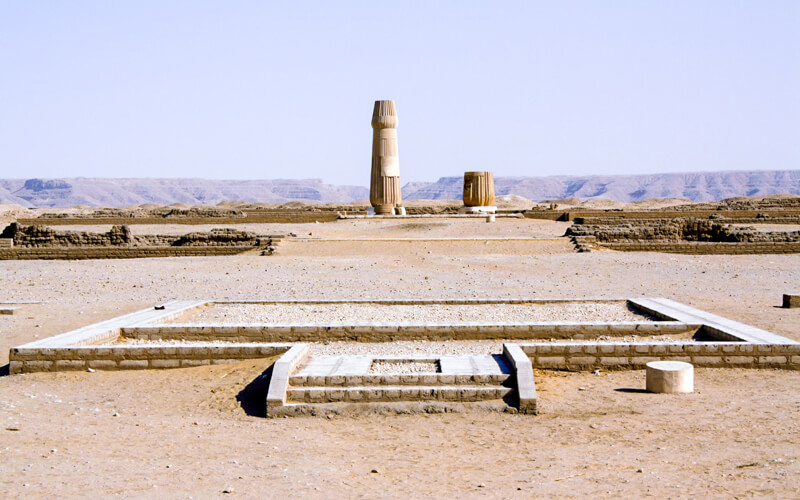At the end of the 18th Dynasty, Egypt’s capital city, Tell El-Amarna, was razed to the ground, and its ruins are now part of a vast Egyptian archaeological complex. Akhenaten ordered the city’s construction in 1346 BC, which was abandoned shortly after his death in 1332 BC when his successors retook the town. “Akhetaten,” which means “horizon of Aten” in Egyptian, is the name given to the city by the ancient Egyptians.
When you talk about Egypt’s many dynasties and periods of control, you can learn many interesting things about its past. Egypt’s massive land area is full of relics from the past that never stop fascinating us.
Archaeological evidence shows that this site is essential and gives us more information about Egyptian life, culture, and history. While you are in Egypt, you should plan to visit the ancient capital of the Egyptian Empire. We have the best Egypt tour packages, from which you can choose the one that works best for you so you can see the fantastic ancient Egyptian sites.
Where is Tell El-Amarna?

The location of Tell El Amarna can be found on Egypt’s east bank of the Nile river, in the Egyptian province of Minya today. It is about 312 kilometers (194 miles) south of Cairo, Egypt’s capital.
What Was Found at Tell El-Amarna?

Tell El Amarna (Akhetaten) is home to several impressive rock tombs and others. Other significant discoveries included 300 cuneiform tablets unintentionally found in 1887 by a peasant lady and portrait statues of Queen Nefertiti in the home of the artist Thutmose.
From there, it was possible to partially recreate the Egyptian empire’s foreign policy during the latter half of the 18th dynasty. We could also mention that we found the head of Akhenaten’s statue in this city.
Even though the successive pharaohs and the people who used its ruins to construct their homes destroyed the city, no new city was ever erected on top of it. Because of this, the trash heaps from that era have allowed us to gather a significant amount of data on life in the disappeared city, including bird feathers and bones, goat and sheep bones, fish bones, barley seers, and more. In light of this, it has been determined that the “Amarnic” diet was balanced and nutrient-rich.
Tell El Amarna Tombs

Today, the most exciting parts of the historical site of Tell El Amarna are the two sets of cliff tombs at each end of the ancient city of Akhet Aton. one north of the wadi that leads to the royal cemetery and the other south of it. Each group is the end of a network of tracks that all lead back to the city.
The tombs are in different stages of completion and are very different from each other.
Some of the paintings and carvings on the walls of these tombs are very interesting and can’t be anywhere else in Egypt. They give visitors a chance to see the unique art of the New Kingdom in ancient Egypt when many aspects of the classical art of the Old and Middle Kingdoms were changed and improved.
Tombs of The Northern Group
The tombs are split into two groups by a wadi. Tombs 1 and 2 are in the north, northeast of the city, and tombs 3–6 are in the south, near the boundary stele. At an elevation of 85 meters, they cut out at the bottom of a vertical cliff that looks out over a rocky rubble slope. A statue of the dead was in a niche at the end of the second room.
Tombs of The Southern Group
This is the biggest group, with 19 tombs that have numbers on them. They were dug out of a series of low cliffs south and east of the city, where the rock was not very good. Their entrance, usually at a lower level, is often clogged up with sediment. Their designs are more varied than those of the tombs in the northern group, but they are not as impressive.
Tell El Amarna Letters | Tell El Amarna Tablets

The Amarna Letters are a group of clay tablets that are at Tell el-Amarna in Egypt. They were written during the 18th dynasty when Amenhotep III and Akhenaton were kings. The Amarna Letters tell us a lot about how big nations and small states dealt with each other diplomatically in the 14th century BCE. They also give us an incomplete but tantalizing hint about the strategic maneuvering that occupied them.
Why Are Amarna Letters Important?
Scholars have learned a lot from the Amarna Letters about how people lived in Egypt then and how Egypt got along with other countries. Once Akhenaten was settled in his new city, these tablets show how little he cared about the king’s duties.


